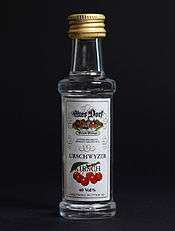Kirsch
A kirschwasser (/ˈkɪərʃvɑːsər/, UK also /-væsər/; German: [ˈkɪʁʃvasɐ], German for "cherry water") or kirsch is a clear, colorless brandy traditionally made from double distillation of morello cherries, a dark-colored cultivar of the sour cherry. However, it is now also made from other kinds of cherries. The cherries are fermented completely, including their stones.[1] Unlike cherry liqueurs and cherry brandies, kirschwasser is not sweet. Kirsch is sometimes produced via the distillation of fermented cherry juice.[2]

The best kirschwassers have a refined taste with subtle flavors of cherry and a slight bitter-almond taste that derives from the cherry seeds.
Serving
Kirschwasser is usually imbibed neat. It is traditionally served cold in a very small glass and is taken as an apéritif. However, people in the German-speaking region where kirschwasser originated usually serve it after dinner, as a digestif.
Kirschwasser is used in some cocktails, such as the Ladyfinger, and the Florida, and the Rose.
High-quality kirschwasser may be served at room temperature, warmed by the hands as with brandy.
Origin and production

Because morellos were originally grown in the Black Forest regions of Germany, kirschwasser is believed to have originated there.
Kirschwasser is colourless because it is either not aged in wood or is aged in barrels made of ash. It may have been aged in paraffin-lined wood barrels or in earthenware vessels.[1]'
In France and in English-speaking countries, clear fruit brandies are known as eaux de vie. The European Union sets a minimum of 37.5% ABV (75 proof) for products of this kind; kirschwasser typically has an alcohol content of 40%–50% ABV (80–100 proof). About 10 kilograms (22 pounds) of cherries go into the making of a 750 ml bottle of kirschwasser.
Food

Kirsch is sometimes used in Swiss fondue and in some cakes,[3] such as the Zuger Kirschtorte. It is also commonly used in the dessert cherries jubilee.
It is used in traditional German Schwarzwälder Kirschtorte (Black Forest cake) and in other cakes—for example in Gugelhupf cake.
Kirsch can also be used in the filling of chocolates. A typical kirsch chocolate consists of no more than one milliliter of kirsch, surrounded by milk or (more usually) dark chocolate with a film of hard sugar between the two parts. The hard sugar acts as an impermeable casing for the liquid content and also compensates for the lack of sweetness that is typical of kirsch. Swiss chocolatiers Lindt & Sprüngli and Camille Bloch, among others, manufacture these kirsch chocolates.
In popular culture
In the Steely Dan song “Babylon Sisters,” the narrator suggests that he and his companion will go to San Francisco and “drink kirschwasser from a shell.”
In the 1943 film The Life and Death of Colonel Blimp, English officer Clive Candy (Roger Livesey) and his former dueling opponent Theo Kretschmar-Schuldorff of the German army (Anton Walbrook) bond over glasses of kirschwasser while recuperating from their respective injuries.
In Thomas Pynchon's novel The Crying of Lot 49, kirsch is mentioned in the opening sentence when the character Oedipa Maas wonders whether the Tupperware party hostess perhaps put too much in the fondue.
In Agatha Christie's Hercule Poirot novel Elephants Can Remember, it is observed that the recurring character Ariadne Oliver prefers to drink kirsch.
See also
- Black Forest cake
- Cherries Jubilee
- Distilled beverage
- Eau-de-vie
- Fruit brandy
- Himbeergeist
- Liqueur
- Schnapps
- Culinary Heritage of Switzerland
References
- Lichine, Alexis. Alexis Lichine's New Encyclopedia of Wines & Spirits (New York: Alfred A. Knopf, 1987), p. 292.
- "Kirsch - distilled liquor". Encyclopedia Britannica. Retrieved March 10, 2019.
- Use of kirsch in a traditional Swiss cake
External links
| Wikimedia Commons has media related to Kirschwasser. |
- Kirsch in the online Culinary Heritage of Switzerland database.